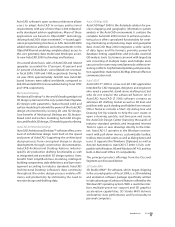Autodesk 2000 Annual Report Download - page 18
Download and view the complete annual report
Please find page 18 of the 2000 Autodesk annual report below. You can navigate through the pages in the report by either clicking on the pages listed below, or by using the keyword search tool below to find specific information within the annual report.
17
Autodesk, Inc. FY 00
Item 7. Management’s Discussion and
Analysis of Financial Condition
and Results of Operations
The discussion in “Management’s Discussion and
Analysis of Financial Condition and Results of Opera-
tions” contains trend analyses and other forward-
looking statements within the meaning of Section 27A
of the Securities Act of 1933 and Section 21E of the
Securities Exchange Act of 1934. All statements, trend
analyses, and other information contained herein
relative to markets for Autodesk’s products and trends
in revenues, as well as other statements including
such words as “anticipate,”“believe,”“plan,”“estimate,”
“expect,”“goal,” and “intend” and other similar expres-
sions, constitute forward-looking statements. These
forward-looking statements are subject to business
and economic risks,and Autodesk’s actual results could
differ materially from those set forth in the forward-
looking statements as a result of the factors set forth
elsewhere herein, including “Risk Factors Which May
Impact Future Operating Results.”
Business Combination and Basis of Presentation
In March 1999, Autodesk acquired Discreet in a busi-
ness combination accounted for as a pooling of
interests. Accordingly, all prior period consolidated
financial statements presented have been restated to
include the combined results of operations of Discreet
as though it had always been a part of Autodesk. The
transaction resulted in the issuance of an aggregate
of approximately 10 million shares of Autodesk com-
mon stock in exchange for Discreet’s outstanding
common stock.
Prior to the acquisition,Discreet’s fiscal year ended on
June 30. As a result of differing year-ends, Autodesk’s
consolidated statements of operations for the fiscal
years ended January 31, 1999 and 1998 were com-
bined with Discreet’s financial statements for the
twelve months ended December 31, 1998, and the
fiscal year ended June 30, 1998, respectively. As
such, Discreet’s operating results for the period from
January 1, 1998 to June 30, 1998 are duplicated in the
consolidated statement of operations for the fiscal
years ended January 31, 1999 and 1998. Discreet’s
revenues, net income, basic net income per share
and diluted net income per share were $75.9 million,
$9.1 million, $0.16 and $0.15, respectively, for the
period January 1, 1998 through June 30, 1998.
In addition, Discreet’s January 1999 results have been
excluded from the consolidated statement of opera-
tions as a result of changing Discreet’s year-end to
January 31. In January 1999, Discreet recognized net
revenues of $3.8 million and incurred a net loss of
$5.0 million.
Results of Operations
Net Revenues
Autodesk’s fiscal 2000 net revenues of $820.2 million
decreased from $871.9 million in fiscal 1999.Increases
in Asia Pacific’s net revenues of 32 percent were more
than offset by decreases of 15 percent and 10 percent
in net revenues in the Americas and Europe, respec-
tively.The overall decrease in net revenues was prima-
rily due to a decline in the sales of AutoCAD and
AutoCAD LT. On a stand-alone basis, sales of AutoCAD
and related upgrades accounted for 37 percent and
45 percent of Autodesk’s consolidated net revenues in
fiscal 2000 and 1999, respectively.
The value of the U.S. dollar, relative to international
currencies, did not have a significant impact on net
revenues in fiscal 2000 compared to the same period
in the prior fiscal year. International sales, including
exports from the U.S., accounted for 65 percent of
Autodesk’s fiscal 2000 revenues compared to 59 per-
cent in the prior fiscal year.
Autodesk’s net revenues increased from $768.7 million
in fiscal 1998 to $871.9 million in fiscal 1999.Revenues
in the Americas and Europe increased 14 percent and
28 percent, respectively, from fiscal 1998, while net
revenues in Asia Pacific decreased slightly for the same
period.The increased revenues resulted primarily from
increased license revenues from new and upgrade
product offerings from Autodesk’s market groups.
On a stand-alone basis, sales of AutoCAD and related
upgrades accounted for 45 percent and 52 percent of
Autodesk’s consolidated net revenues in fiscal 1999
and 1998, respectively. The value of the U.S. dollar,
relative to international currencies, did not have a
significant impact on net revenues in fiscal 1999 as
compared to fiscal 1998.
Autodesk derives a substantial portion of its revenues
from sales of AutoCAD software, AutoCAD upgrades
and vertical products that are interoperable with
AutoCAD, and expects this trend to continue. As such,
any factor adversely affecting sales of AutoCAD and
AutoCAD upgrades, including such factors as product
life cycle, market acceptance, product performance
and reliability, reputation, price, competition and the
availability of third-party applications, could harm
























